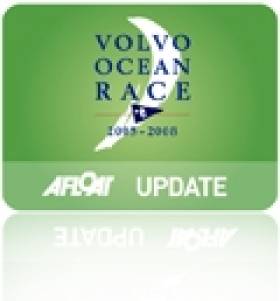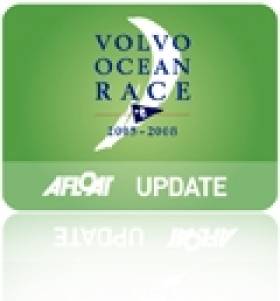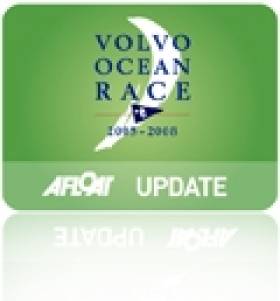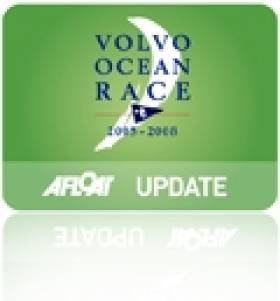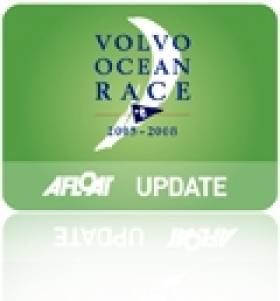Displaying items by tag: Gothenburg
#VOR - Ian Walker and his victorious Abu Dhabi Ocean Racing crew have the chance of a rare double today (Saturday 27 June) when they attempt to win the Volvo Ocean Race In-Port Series Trophy.
They are hot favourites to do so, taking a six-point advantage into the Inmarsat In-Port Race Gothenburg, the final race in a 10-part series.
Only a victory for their nearest competitors Team Brunel (Bouwe Bekking/NED) and a last-place finish, or a failure to complete the course, can deny Walker’s men from collecting another piece of handsome silverware.
They have already sealed the overall offshore trophy with five points to spare, again from the Dutch crew of Bouwe Bekking, after finishing fifth in the ninth and final leg from Lorient, France to Gothenburg, Sweden on Monday 22 June.
The offshore and in-port double is not unique in Volvo Ocean Race history – Mike Sanderson’s ABN AMRO ONE achieved it in 2005-06 – but victory would be another major feather in the cap for a region, which only entered the 41-year-old event for the first time in 2011-12 under the Abu Dhabi flag.
Walker, 45, was typically taking nothing for granted in the final press conference for the nine-month race today. “We try to win everything we do,” he said. “Basically, we just have to make sure we don’t finish last.
“But it’s a pretty tight race course and there’s plenty of trouble out there if you’re not careful.”
Bekking, 52, could be forgiven for being sick of the sight of Abu Dhabi Ocean Racing’s stern after trying to catch it over 38,739 nautical miles and nine offshore legs since the race started back in October last year from Alicante, Spain.
However, he has not totally given up hope of an upset result that will rely on his opponents slipping up uncharacteristically badly.
“We will fight for it and we still have a slight chance,” he told reporters. “It would certainly be nice to win that trophy.”
Today's in-port race, which concludes the 12th edition of the triennial sailing event, will also resolve some unfinished business in the overall competition as a tie-breaker.
Team Alvimedica’s (Charlie Enright/USA) Leg 9 win in Gothenburg from Lorient via a manic pit-stop in The Hague last week drew them level with MAPFRE (Iker Martínez/ESP) on 34 points, in joint fourth place overall.
The Turkish/American team currently stand two points ahead of the Spanish crew, but that advantage could easily be swept away on a tight, challenging Gothenburg course.
MAPFRE were boosted by an eve-of-race visit to the boat in Gothenburg from King Juan Carlos of Spain yesterday. He will be an onboard spectator with the Spanish flag-bearers in today's race – if the weather is good.
"I haven't sailed for four years and I'm really looking forward to it," he told reporters.
Team SCA (Sam Davies/GBR), presently fourth behind Team Alvimedica, and, less likely, sixth-placed Dongfeng Race Team (Charles Caudrelier/FRA), also have outside chances of a top-three podium place in the in-port series if results go their way.
Team Vestas Wind (Chris Nicholson/AUS) will largely be racing for pride having missed all but the Alicante, Cape Town, Lisbon and Lorient in-port races because of their grounding in the Indian Ocean during Leg 2.
The action will start at 1pm local time and so far the forecasters are predicting strong enough winds to offer the prospect of a fitting finale to a memorable and extraordinarily close-run event all round.
No Sleep Till Gothenburg As Team Alvimedica Leads Volvo Ocean Race Fleet Out Of The Hague
#VOR - Team Alvimedica led the Volvo Ocean Race fleet out on the final ‘sprint’ to Gothenburg today, as the seven teams bade farewell to The Hague after a hugely successful pit-stop in the famous old Dutch port.
The Turkish/American boat skippered by Charlie Enright (USA) retained the 1hr 46min lead they established in the first part of the 1,000-nautical mile-plus ninth and final leg from Lorient, France to Gothenburg in Sweden, having arrived just after 1.30am local time on Friday morning (19 June).
The seven boats have around two-and-a-half days of challenging sailing ahead of them in fluctuating wind and sea states, with the possibility of a compression of the fleet as the breeze drops further into the leg.
They also must steer clear of numerous Traffic Separation Schemes (TSS), which litter their paths and have already caused penalty points for three teams in earlier legs following inadvertent infringements.
Leg 9 victory in Gothenburg would taste so sweet for Enright and the youngest crew in the race, which is also peppered with experience including 50-year-old navigator Will Oxley (AUS), who is taking on his fourth Volvo Ocean Race.
Team Alvimedica have yet to score a leg win since the race began in early October, and nothing would delight Enright more than to follow Leg 8 winners Team SCA (Sam Davies/GBR) in making the breakthrough.
It would also give them an outside chance of an overall podium place, although a showdown for fourth spot looks more likely for them.
Enright and his crew departed at 12 noon local time today (Saturday 20 June) in around seven knots of breeze.
“Once we get out of here we’ve got a lot of decisions to make,” he told a pre-departure press conference. “There’s the TSS zones and which way we’re going to go. Some of the guys who are still in the dock can sit back and see which way we go and whether it works out for us. But that’s the same for any lead in this race.”
If the positions remain the same on arrival in Gothenburg as when the fleet finished in The Hague, Team Alvimedica would find themselves in the interesting position of being locked in joint fourth place on 34 points with MAPFRE (Iker Martínez/ESP). The Spanish boat left port in third place.
That tie could only then be broken by the In-Port Race Series that reaches its own finale next Saturday 27 June with the Inmarsat In-Port Race Gothenburg.
A similar situation exists for second place, where Dongfeng Race Team (Charles Caudrelier/FRA) are attempting to claw back a two-point deficit on current runners-up Team Brunel (Bouwe Bekking/NED).
The Chinese boat was second out of the harbour in The Hague, 1hr 46min behind Team Alvimedica, in three to four knots more wind speed than Enright’s crew.
Team Brunel, who exited fourth, were given a late royal boost when the Dutch King Willem-Alexander visited the crew prior to their mid-afternoon departure.
Although the race will not receive official figures on attendance for several days, early estimates show some of the biggest crowds of the entire race – measured in the tens of thousands per day – have seen the boats close-up in the port in Scheveningen.
Team Vestas Wind (Chris Nicholson/AUS) and, finally, Team SCA (Sam Davies/GBR) were last to leave The Hague, the latter 4hrs 32mins after Team Alvimedica.
Meanwhile, Abu Dhabi Ocean Racing (Ian Walker/GBR) were simply hoping to avoid any mishaps on their way to what should be huge celebrations for them as overall Volvo Ocean Race 2014-15 champions in Gothenburg.
The Emirati boat and crew – including Ireland's own Justin Slattery – hold an unassailable eight-point lead at the top of the standings and only last place in Leg 9, victory for Team Brunel, and a two-point penalty can ruin their moment of glory now.
“We’re in a kind of strange position,” summed up Azzam’s skipper Ian Walker. “It shouldn’t matter where we finish, but of course it does, because we have a lot of pride and we want to do as well as we can. We’ll be very, very careful and just make sure we don’t do anything stupid.”
#VOR - The Volvo Ocean Race fleet set off for Gothenburg from Lorient in perfect sailing conditions today (Tuesday 16 June) with Team Brunel (Bouwe Bekking/NED) leading the chase to reach the pit stop in The Hague.
There was drama from the very first seconds with Leg 8 winners Team SCA (Sam Davies/GBR) and Team Alvimedica (Charlie Enright/USA) both finding themselves on the wrong side of the line at the start and were forced back to cross for a second time.
Bouwe Bekking, in contrast, stormed away to the perfect start and was still narrowly ahead as he led the fleet out of a packed Lorient with all six boats in hot pursuit after five laps around the port.
Team Brunel, like three other boats, has a podium position to sail for in this final 960-nautical-mile leg to Sweden after more than eight months at sea, despite Abu Dhabi Ocean Racing (Ian Walker/GBR) already having the overall title virtually sewn up with an unassailable eight-point lead.
The Dutch boat is currently in second place on 27 points after eight legs, two clear of Dongfeng Race Team (Charles Caudrelier), and four ahead of MAPFRE (Iker Martínez/ESP).
All have the chance of finishing in second if the last leg results go their way, and even fifth-placed Team Alvimedica (Charlie Enright/USA) on 33 points could sneak in to grab the runners-up spot if they end up as leg winners and their rivals finish down the field.
Both Team SCA and Team Vestas Wind, first and second from Lisbon into Lorient last week, will be determined to put a spoke in all their wheels and repeat the previous stage’s somewhat surprising finish.
As Ian Walker put it, meanwhile, his tactics on board Abu Dhabi Ocean Racing are pretty simple on a stage which is full of exclusion zones, avoiding a busy shipping route skirted by rocks: “Don’t hit any rocks and avoid breaking any rules.”
Bekking would like nothing better than be first to reach The Hague in his home country, probably on Friday, a belated birthday present as he turns 52 years old tomorrow (17 June).
“We just have to beat them, it’s easy,” he said in an interview dockside before the action started at 5pm local time.
“We have no strategy as such but, of course, we’re going to keep an eye on the guys. It will be massive to go home [The Hague] but we know it’s just a stop and it’s all about the finish in Gothenburg.”
Another birthday boy, Iker Martínez onboard MAPFRE, who turns 38 today, said that the leg offers fairly unique challenges.
“There are lots of rocks involved, and our first priority is not to hit the rocks," he put it matter-of-factly.
“There’s going to be lot of current, but it’s difficult to know where the key of the leg is going to be. We could arrive in Scheveningen and then the whole thing starts again. The best thing is to be in front in any case.”
Charlie Enright of Team Alvimedica agreed, adding: “We are in a really complicated situation – but at least we know it’s complicated.”
The boats will be precisely timed as they pass the interim line in Scheveningen, near The Hague, on Friday 19 June. No points will be awarded for how they finish there.
From 12 noon local time onwards the following day, they will depart for Gothenburg with whatever advantage or deficit they took into the pit stop on their rivals. They are expected to arrive in Gothenburg on Monday 22 June 22 or possibly the following day.
The nine-month, 38,739-nautical-mile marathon event will finally come to a halt in the famous maritime Swedish city on Saturday 27 June with the Inmarsat In-Port Race Gothenburg.
Lorient Stopover Completes Next VOR Race Route
#VOR - Lorient in France completes the route for the next edition of the Volvo Ocean Race.
Like last year, the Brittany port city will be the penultimate stopover for the race fleet when they sail in at some point in mid June 2015.
But rather than a return to Galway, the race will continue on to the new finish line at Gothenburg in Sweden - as announced by race organisers in February.
“This route has never really been part of any ocean race any time before,” said Volvo Ocean Race CEO Knut Frostad. “And when you have that element there’s a new strategy, there’s a new route, there’s new weather, there’s new challenges for the sailors.
"That is exciting, not only for us but for the sailors because no-one can claim they’ve done this before.”
The 12th edition of the Volvo Ocean Race begins on 4 October this year with the first in-port race in Alicante.
In other VOR news, Team SCA has selected the first five members of its all-woman team for the global yachting challenge.
Britons Sam Davies and Annie Lush will be joined by Dutchwoman Carolijn Brouwer and Aussie par Sophie Ciszek and Liz Wardley on the squad that marks the first female-only crew in the race for more than a decade.
Newport Makes It Six For VOR 2014-15 Host Ports
#VOR - Newport in Rhode Island has been announced as the latest stopover for the next edition of the Volvo Ocean Race in 2014-15.
The popular sailing base in the 'Ocean State' will be the North American port on the race route for its 12th running as the end point of the leg from Itajaí in Brazil, and is hosting the event for the first time.
"It's about time the race came to the city of Newport and we are looking forward to a real festival that will delight and inspire sailing fans and those who are new to the sport," said Volvo Ocean Race CEO Knut Frostad at the announcement.
Conveniently located between the Irish-American hotspots of New York City and Boston, the crowds in attendance are sure to feature a prominent 'green' element.
As reported at the weekend on Afloat.ie, Gothenburg in Sweden has been awarded the honour of hosting the VOR finale, much to the disappointment of Galwegians after last summer's successful event.
Volvo Ocean Race Finale Honours Go To Gothenburg For 2015
#VOR - Despite hopes within Galway after last summer's successful conclusion to the Volvo Ocean Race, it's been announced that the next edition of the round-the-world yachting challenge will have its finish line in Sweden.
Gothenburg was chosen last week as the final stop for the 12th running of the Volvo Ocean Race in 2014-15. It will be the second time the city - also the headquarters of the title sponsor - has hosted the race after the 2005-06 running.
"Gothenburg is the perfect place to finish a global event of this stature," said Volvo Ocean Race CEO Knut Frostad. "It's great to know that after sailing tens of thousands of miles around the world we'll be coming to a host port with all the facilities and knowhow to make this a great event, and the history to make it feel like a real homecoming."
The deal announced on Friday also secures Gothenburg's place on the race route for the 13th edition of the race.
It is the fifth of the hosts port announced so far, after the race start at Alicante in Spain, two stopovers in Brazil and a return visit to Auckland in New Zealand.
According to Galway Bay FM, the City of the Tribes is still in the running among 100 host cities that have registered an interest to host the VOR on its next sail around the world.
This is despite claims that last summer's finale organiser Let's Do It Global could be faced with liquidation due to failure to meet its outstanding debts from the event, said to amount to almost half a million euro.
As previously reported on Afloat.ie, Dun Laoghaire may consider its own tender to host the race to cash in on the success of the event for local business and tourism in Galway last year.


























